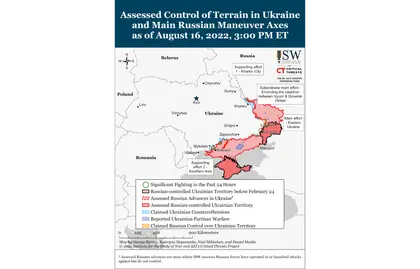Key Takeaways
- Russian forces conducted ground attacks across the Eastern Axis but failed to advance northwest of Slovyansk and east of Siversk.
- Russian forces are launching offensive operations around Bakhmut, southwest of Avdiivka, and southwest of Donetsk City.
- Russian forces conducted unsuccessful offensive operations in northern and northwestern Kherson Oblast.
- The Russian Defense Ministry claimed that Ukrainian forces in Nikopol are preparing to conduct provocations at the Zaporizhia Nuclear Power Plant, possibly setting information conditions for further shelling of Nikopol or provocations of its own.
- Chechen units are reportedly relocating to Kherson Oblast to police Russian military deserters.
- Russian forces struggle to recruit soldiers even for safe, prestigious jobs.
Russian and Ukrainian sources reported explosions at an airfield and a critical Russian supply nexus in Crimea on August 16. Local reports and videos show a series of explosions at a Russian ammunition depot and a transformer substation in Dzhankoiskyi District and an airfield near Hvardiiske, Crimea.[1] These explosions both caused significant damage to Russian resources and seriously disrupted Russian logistics. Russian forces have used Dzhankoi as a railway hub for transporting troops and equipment to occupied settlements in southern Zaporizhia Oblast, including Melitopol.[2] Russian authorities temporarily suspended passenger rail service from Russia into Crimea following the attack.[3]
Ukrainian forces have not officially claimed responsibility for these explosions. The New York Times reported that an anonymous senior Ukrainian official attributed the explosions in Dzhankoiskyi District to “an elite Ukrainian military unit operating behind enemy lines,” but no Ukrainian official has publicly come forward to claim responsibility.[4] The Russian Ministry of Defense released a statement calling the explosions “a result of sabotage.”[5]
A Ukrainian strike on logistical targets in Crimea, which is the sovereign territory of Ukraine, would not violate Ukrainian commitments to Western partners regarding Ukraine’s use of Western-supplied weapons within Ukrainian territory or stated US policy regarding Ukraine’s right to use force to regain control of all its territory including areas seized by Russia in 2014.[6] There are no indications that Ukrainian forces used US-supplied weapons in recent strikes on Crimea, and it is unlikely that they did since the targets are well beyond the range of the US-provided systems.

ISW Russian Offensive Campaign Assessment, January 21, 2025
Attacks on Russian positions in and around Crimea are likely part of a coherent Ukrainian counter-offensive to regain control of the west bank of the Dnipro River. Russian supply lines from Crimea directly support Russian forces in mainland Ukraine including those in western Kherson Oblast. Ukraine’s targeting of Russian ground lines of communication and logistic and support assets in Crimea is consistent with the Ukrainian counteroffensive effort that has also targeted bridges over the Dnipro River and Russian logistical support elements in occupied Kherson Oblast.[7] The net effects of this campaign will likely be to disrupt the ability of Russian forces to sustain mechanized forces on the west bank of the Dnipro River and to defend them with air and artillery assets on the east bank from Ukrainian counterattacks.
The Kremlin continues efforts to misrepresent its likely maximalist goals in Ukraine. ISW assesses that Russian strategic objectives remain unchanged: changing the regime change in Kyiv and securing territorial control over most of Ukraine. Russian President Vladimir Putin omitted mention of territory outside of Donbas while describing the goals of Russia’s war in Ukraine on August 15. Putin closed his preliminary remarks to the Army-2022 forum on August 15 with the claim that Russian and Donbas forces are “doing their duty” to fight for Russia and “liberate” Donbas.[8] Such a limited statement of Russian goals sharply contrasts with previously articulated Russian war goals to “denazify” and “demilitarize” all of Ukraine. Putin‘s relatively limited statement additionally is incompatible with Russian actions to integrate occupied parts of Kherson and Zaporizhia Oblasts into the Russian Federation.
Authors: Kateryna Stepanenko, Grace Mappes, Angela Howard, George Barros, and Frederick W. Kagan
See the full report here.
You can also highlight the text and press Ctrl + Enter










